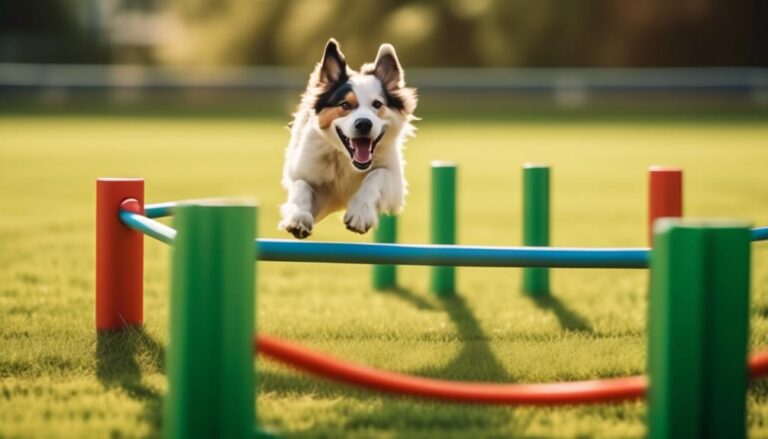5 Tips for Successfully Training Your Canine Companion

5 Tips for Successfully Training Your Canine Companion will be a rewarding experience for both you and your furry friend. Whether you’re a first-time dog owner or an experienced trainer, these 5 tips will help you establish a strong bond with your pet and ensure they become a well-behaved member of your family. From starting early to using positive reinforcement, these proven techniques will make the training process enjoyable and effective. Keep reading to unlock the secrets of successful dog training and transform your canine companion into the perfect pet.
Tip 1: Importance of Early Training
Training your canine companion early is the key to successful dog training. Puppies have a shorter attention span, and they are more receptive to learning than adult dogs. That’s why it’s crucial to start training your puppy as soon as possible. Early training helps to establish good habits and behaviors in your puppy, making it easier to correct any bad habits they may develop later on.
How to Train Puppies vs. Adult Dogs
Training puppies and adult dogs requires different approaches. Puppies are like sponges, and they are eager to learn new things. You can use positive reinforcement, treats, and praise to motivate your puppy to learn. As for adult dogs, they already have established habits and behaviors that may be difficult to change. However, it’s not impossible to train an adult dog. You need to be patient, and consistent and use positive reinforcement to teach your adult dog new behaviors.
Tip 2: The Power of Positive Reinforcement in Canine Training
When it comes to training your furry friend, one of the most effective methods is positive reinforcement. This training technique is all about rewarding your dog for good behavior rather than punishing them for bad behavior. Using positive reinforcement can create a positive and enjoyable learning experience for your dog, making the training process much easier and more effective.
Benefits of Positive Reinforcement
One of the biggest advantages of using positive reinforcement is that it creates a strong bond between you and your pet. When you reward your dog for good behavior, it helps to build trust and respect, making it easier for them to learn new commands and behaviors.
Positive reinforcement can also help to prevent fear and anxiety in dogs. Punishing your dog for bad behavior can create a stressful and negative learning environment, which can lead to behavioral problems down the line. By using positive reinforcement, you can create a safe and enjoyable learning experience for your dog, which can help to prevent these issues.
Types of Rewards to Use in Training
There are many different types of rewards you can use in canine training. Some popular choices include treats, verbal praise, and toys. When choosing a reward, it’s important to consider what motivates your dog. Some dogs may be more food-motivated, while others may prefer toys or verbal praise.
It’s also important to choose rewards that are appropriate for the behavior you are trying to reinforce. For example, if you are teaching your dog to sit, a small treat or verbal praise may be appropriate. If you are teaching your dog a more complex behavior, such as coming when called, a higher-value reward, such as a favorite toy or a longer play session, may be more effective.
When using rewards in training, it’s important to be consistent and to only reward good behavior. This will help your dog understand what is expected of them and will make the training process much easier.
By using positive reinforcement and choosing appropriate rewards, you can create a fun and effective training experience for your furry companion. In the next section, we will discuss the importance of consistency in canine training.
Tip 3: Be Consistent
Why Consistency is Important
Consistency is a crucial aspect of dog training that every pet owner should prioritize. It is essential to maintain consistency in training because dogs thrive on routine and predictability. When you are consistent, your dog knows what to expect, making it easier for them to understand what is expected of them. This creates a better learning experience for your furry friend, making training more effective and enjoyable.
Moreover, consistency helps to prevent confusion in dogs. When you use the same commands and rewards every time, your dog learns to associate the two, making it easier for them to understand what is expected of them. On the other hand, varying your commands or rewards can confuse your dog and cause inconsistent behavior.
How to Maintain Consistency in Training
Maintaining consistency in dog training requires dedication and patience. Here are some tips to help you stay consistent:
- Use the same commands and rewards every time you train your dog.
- Stick to a regular training schedule.
- Stay patient and persistent, even if it takes longer than expected for your dog to learn.
- Involve all members of your household in training to ensure consistency.
Remember, consistency is not just important during training sessions, but also in your day-to-day interactions with your dog. Reinforcing good behavior consistently throughout your dog’s life can help prevent behavioral problems from developing later on.
——————————-
Get access to the best pet discounts, items, and training by clicking the link below
————————————-
Tip 4: The Importance of Patience in Dog Training
The Value of Patience
Patience is an essential trait when it comes to training your dog. Dogs learn at their own pace, and it is crucial to give them enough time to understand and respond to the training. Being calm and patient during training sessions will help your dog feel comfortable, safe, and happy. When you show patience, you reduce the risk of your dog feeling stressed, anxious, and intimidated.
Staying patient can be challenging, particularly when your dog is not responding to your commands. However, it is essential to remember that training is a gradual process that requires time, repetition, and consistent reinforcement. Even if your dog is not responding to your commands right away, stay calm and keep at it. Remember that being patient is the key to achieving long-term success in dog training.
Tips for Staying Patient During Training Sessions
Here are some tips to help you stay patient during training sessions:
- Stay Calm: Dogs are sensitive to their owner’s emotions. If you become frustrated or angry during training, your dog will sense it and become anxious. To avoid this, stay calm and take deep breaths if you need to.
- Take Breaks: If you or your dog are feeling overwhelmed or frustrated, take a break. This will give you both time to relax, recharge, and come back to training refreshed.
- Lower Your Expectations: Do not expect your dog to learn everything in one session. Dogs learn at their own pace, and it may take several sessions before they respond to your commands. Be patient, and celebrate small victories along the way.
- Use Positive Reinforcement: Reward your dog with treats, praise, or playtime when they respond to your commands. Positive reinforcement is more effective than punishment and will help to keep your dog motivated and engaged during training.
- Be Consistent: Use the same commands and rewards every time you train your dog. Consistency will help your dog understand what is expected of them and reduce confusion and frustration.
By following these tips, you can stay patient during training sessions and create a positive and enjoyable learning experience for your dog. Remember, training takes time, but patience and consistency will lead to long-term success.
Tip 5: How Often to Train Your Dog
Recommended Length of Training Sessions
When it comes to training your furry friend, it is important to keep in mind that dogs have a shorter attention span than humans. As such, it is recommended to keep training sessions short and sweet. Ideally, training sessions should last between 5-10 minutes at a time. This is because shorter sessions are more effective for learning and prevent your dog from becoming bored or overwhelmed.
How Often to Train Your Dog
Consistency is key when it comes to dog training. It is important to train your dog regularly and consistently. This helps them to understand that the behavior you are teaching them is expected all the time, not just when they feel like it.
Training sessions can be held multiple times a day, depending on your schedule and your dog’s needs. It is recommended to train your dog for at least 15 minutes a day, but you can increase the frequency depending on your dog’s age and energy level.
It is important to keep in mind that overtraining your dog can lead to burnout and even regression. Be sure to give your furry friend plenty of time to rest and recover after each session.
Remember, training your dog takes time and patience. Consistency, positive reinforcement, and short training sessions can go a long way in helping your dog learn new skills and behaviors.
Conclusion
Training your canine companion can be a challenging but rewarding experience. By following the tips outlined in this article, you can set yourself and your dog up for success. Starting early, using positive reinforcement, being consistent and patient, and keeping sessions short and frequent are key factors in achieving effective dog training. It’s also important to remember to socialize your dog, reward good behavior, and seek professional help if needed.
Remember, training your dog is a process that takes time and dedication. Be patient and consistent, and always approach training with a positive attitude. With the right techniques and mindset, you can turn your furry friend into a well-behaved companion that brings joy and happiness to your life. Happy training!
5 Tips for Successfully Training Your Canine Companion FAQ:
What are the best methods for training my dog?
The most effective methods for training your dog include positive reinforcement, clicker training, and obedience training. Positive reinforcement involves rewarding your dog for good behavior, while clicker training uses a clicking sound to signal good behavior. Obedience training involves teaching your dog basic commands like sit, stay, and come. Check out this article on basic dog training for more information.
How can I make training fun for my furry friend?
Training can be enjoyable for both you and your dog! Use treats, toys, and praise as rewards to keep your dog motivated and engaged. Incorporate games like hide-and-seek or fetch to make training sessions more enjoyable. Remember to keep training sessions short and frequent to avoid overwhelming your dog. This article on fun ways to train your dog has more great ideas.
What should I do if my dog is not responding to training?
If your dog is not responding to your training methods, it may be time to seek professional help. A certified dog trainer can provide you with expert advice and guidance to help you and your dog succeed. Additionally, consider reassessing your training methods and making adjustments as needed. This article on the seven stages of dog training can help you identify areas where you may need to improve.
How long does it take to train a dog?
The length of time it takes to train a dog depends on a variety of factors, including the dog’s age, breed, and temperament. Some dogs may learn quickly and respond well to training, while others may require more time and patience. Consistency and persistence are key when it comes to training your dog. It’s important to set realistic expectations and celebrate small victories along the way. This article on how long it takes to train a dog provides additional insight.
What should I do if my dog is misbehaving?
If your dog is misbehaving, it’s important to identify the root cause of their behavior. Common causes of misbehavior include anxiety, boredom, and a lack of exercise. Consider consulting with a veterinarian or certified dog trainer to rule out any underlying medical conditions and to develop a plan to address your dog’s behavior. This article on how to stop a dog from misbehaving offers some helpful tips.
What Are the 5 Golden Rules of Dog Training?
The 5 golden rules of dog training include using positive reinforcement, consistency, and repetition, understanding dog body language, setting clear boundaries, and practicing patience and persistence.
What Is the Number One Rule in Dog Training?
The number one rule in dog training is to use positive reinforcement techniques. Building a strong bond with your dog, consistency in training methods, and patience and understanding are also important.
What Are the 7 Commands to Train a Dog?
To train your dog, start with basic obedience commands like sit, stay, and come. Consistency is key, so use positive reinforcement and effective leash training methods. Teach your dog to lie down, leave it, and walk politely on a leash.
What Is the Most Effective Dog Training Method?
The most effective dog training method is positive reinforcement. It involves using treats as motivation, incorporating clicker training benefits, and reward-based training methods. Consistency, body language, leash training, socialization, breed characteristics, and play are also important factors.








